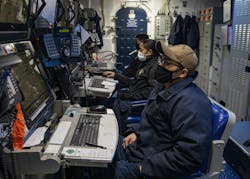Navy asks GE Vernova for a megawatt-scale hybrid modular converter for electric power ship propulsion
Summary points:
- GE Vernova Naval Systems will prototype a megawatt-scale hybrid modular converter to support advanced naval propulsion systems.
- Converter will enable efficient power distribution for submarines, aircraft carriers, surface warships, and high-energy weapons.
- System integrates next-generation semiconductors like SiC MOSFETs to enhance performance, fault tolerance, and power scaling in demanding applications.
ARLINGTON, Va. – U.S. Navy researchers needed to develop a megawatt-scale advanced converter to provide enough electric power for Navy propulsion drive applications. They found a solution from GE Vernova naval systems segment in Imperial, Pa.
Officials of the Office of Naval Research in Arlington, Va., announced a $10.4 million order to GE Vernova Naval Systems in late June for rapid prototyping of the power electronics building block (PEBB) and hybrid modular multi-level converter (HMMC) Phase 3 effort.
GE Vernova will continue developing and prototyping of a megawatt scale hybrid modular multi-level converter to validate, test, and mature hybrid modular multi-level power conversion technology for Navy propulsion drive applications.
The Navy will use hybrid modular multi-level converter technology for nuclear propulsion for submarines and aircraft carriers; gas turbine propulsion in naval aviation; electric drive propulsion for surface warships; and efficient power distribution for weapons and sensors like laser weapons, RF electromagnetic weapons, and radar.
Power-conversion applications
The Power Electronics Building Block is part of different power-conversion applications, like AC-DC, DC-DC, and DC-AC conversion. These subsystems help with rapid assembly of complex power electronic systems by combining several blocks.
These power subsystems typically use semiconductors like insulated gate bipolar transistors (IGBT) and metal oxide silicon field effect transistors (MOSFETs), together with advanced driver circuits. They can offer charge-pump power supplies and optical isolation for high-voltage operations.
The Hybrid Modular Multi-Level Converter combines different types of submodules in series and in parallel to enhance performance, efficiency, and fault tolerance in high-power applications like ship propulsion, large-scale energy storage, and high-voltage DC transmission.
Scaling power and voltage
GE Vernova is focusing on scaling power and voltage levels for demanding environments; enhancing reliability and fault management; integrating next-generation semiconductors like SiC MOSFETs for improved efficiency and switching.
The company also is trying to improve power electronics building blocks to provide low-voltage direct current/alternating current applications and medium voltage direct-current and alternating-current applications. The company seeks to demonstrate a medium-voltage megawatt-scale hybrid modular multi-level converter and low-voltage kilowatt-scale power electronics building block subsystems.
On this order GE Vernova will do the work in Imperial, Pa., and should be finished by June 2027. For more information contact GE Vernova Naval Systems online at www.gevernova.com/power-conversion/industries/Marine/Naval, or the Office of Naval Research at www.onr.navy.mil.
About the Author
John Keller
Editor-in-Chief
John Keller is the Editor-in-Chief, Military & Aerospace Electronics Magazine--provides extensive coverage and analysis of enabling electronics and optoelectronic technologies in military, space and commercial aviation applications. John has been a member of the Military & Aerospace Electronics staff since 1989 and chief editor since 1995.
